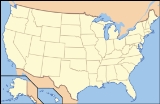
John and Louise Seier National Wildlife Refuge
Encyclopedia
John and Louise Seier National Wildlife Refuge is located in the U.S. state
of Nebraska
and includes 2,400 acres (9.71 km2). The refuge protects a portion of the largest remaining area of tall and mid grass prairie
remaining in the U.S. Collectively known as the Sand Hills
region of Nebraska, the dunes were the end result of the last ice age
known as the Pinedale glaciation. During the Holocene glacial retreat
the sand dunes that been deposited in their current location by the vast continental glaciers, were exposed and grasses eventually took over. The refuge is managed by the U.S. Fish and Wildlife Service and along with Fort Niobrara
and Valentine National Wildlife Refuge
s, form the Fort Niobrara National Wildlife Refuge Complex.
This is an undeveloped refuge that was donated by the siblings, John Seier and his sister Louise to the U.S. Government to be preserved for wildlife. The Seier family had homesteaded
the lands in the mid-19th century. The refuge is part forest and part wetland but the majority of it is tall grass prairie
.
John and Louise Seier NWR is located about 25 miles (40.23 km) south of Bassett, Nebraska, off of U.S. Highway 183. The refuge is not open to the public.
U.S. state
A U.S. state is any one of the 50 federated states of the United States of America that share sovereignty with the federal government. Because of this shared sovereignty, an American is a citizen both of the federal entity and of his or her state of domicile. Four states use the official title of...
of Nebraska
Nebraska
Nebraska is a state on the Great Plains of the Midwestern United States. The state's capital is Lincoln and its largest city is Omaha, on the Missouri River....
and includes 2,400 acres (9.71 km2). The refuge protects a portion of the largest remaining area of tall and mid grass prairie
Prairie
Prairies are considered part of the temperate grasslands, savannas, and shrublands biome by ecologists, based on similar temperate climates, moderate rainfall, and grasses, herbs, and shrubs, rather than trees, as the dominant vegetation type...
remaining in the U.S. Collectively known as the Sand Hills
Sand Hills (Nebraska)
The Sand Hills, often written Sandhills, is a region of mixed-grass prairie on grass-stabilized sand dunes in north-central Nebraska, covering just over one quarter of the state...
region of Nebraska, the dunes were the end result of the last ice age
Ice age
An ice age or, more precisely, glacial age, is a generic geological period of long-term reduction in the temperature of the Earth's surface and atmosphere, resulting in the presence or expansion of continental ice sheets, polar ice sheets and alpine glaciers...
known as the Pinedale glaciation. During the Holocene glacial retreat
Holocene glacial retreat
Holocene glacial retreat had a profound effect on landscapes in many areas that were covered by ice at the Last Glacial Maximum. The many valleys of the Cairngorms, a mountainous region in the Eastern Scottish Highlands are littered with deposits from this period.-Evidences of the retreat of the...
the sand dunes that been deposited in their current location by the vast continental glaciers, were exposed and grasses eventually took over. The refuge is managed by the U.S. Fish and Wildlife Service and along with Fort Niobrara
Fort Niobrara National Wildlife Refuge
Fort Niobrara National Wildlife Refuge is located in the U.S. state of Nebraska and includes 19,131 acres . The refuge borders the Niobrara National Scenic River on the west and is managed by the U.S. Fish and Wildlife Service. From 1879 to 1906, the Fort Niobrara Military Reservation was...
and Valentine National Wildlife Refuge
Valentine National Wildlife Refuge
Valentine National Wildlife Refuge is located in the U.S. state of Nebraska and includes 19,131 acres . The refuge protects a portion of the largest remaining area of tall and mid grass prairie remaining in the U.S. Collectively known as the sand hills region of Nebraska, the dunes were the...
s, form the Fort Niobrara National Wildlife Refuge Complex.
This is an undeveloped refuge that was donated by the siblings, John Seier and his sister Louise to the U.S. Government to be preserved for wildlife. The Seier family had homesteaded
Homestead Act
A homestead act is one of three United States federal laws that gave an applicant freehold title to an area called a "homestead" – typically 160 acres of undeveloped federal land west of the Mississippi River....
the lands in the mid-19th century. The refuge is part forest and part wetland but the majority of it is tall grass prairie
Prairie
Prairies are considered part of the temperate grasslands, savannas, and shrublands biome by ecologists, based on similar temperate climates, moderate rainfall, and grasses, herbs, and shrubs, rather than trees, as the dominant vegetation type...
.
John and Louise Seier NWR is located about 25 miles (40.23 km) south of Bassett, Nebraska, off of U.S. Highway 183. The refuge is not open to the public.

